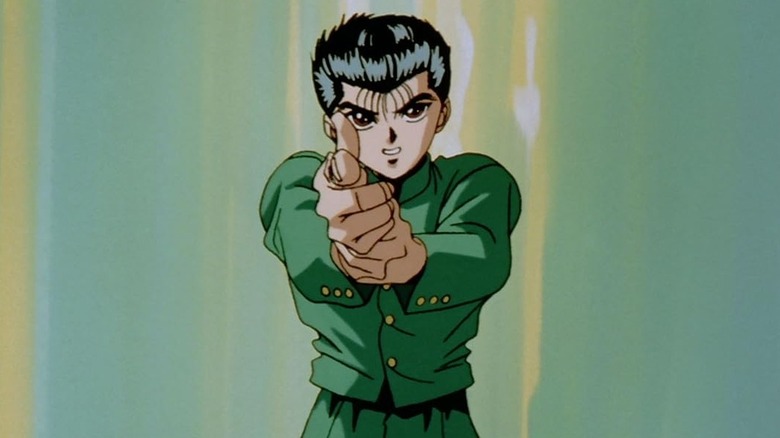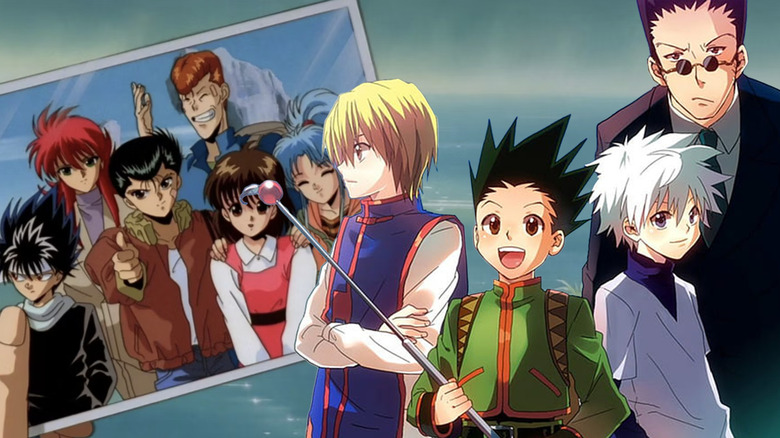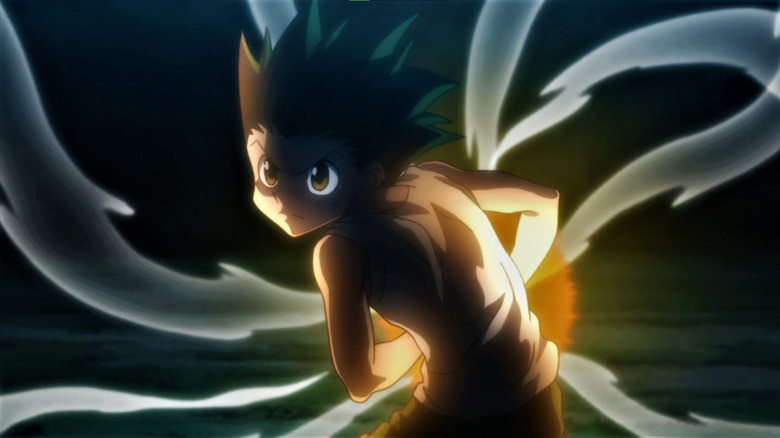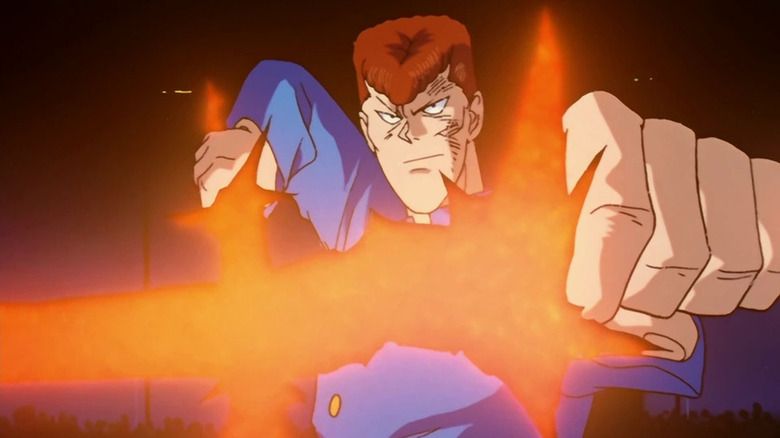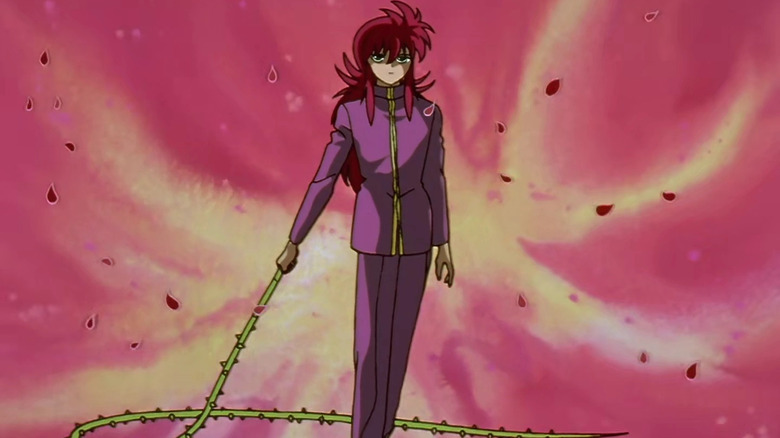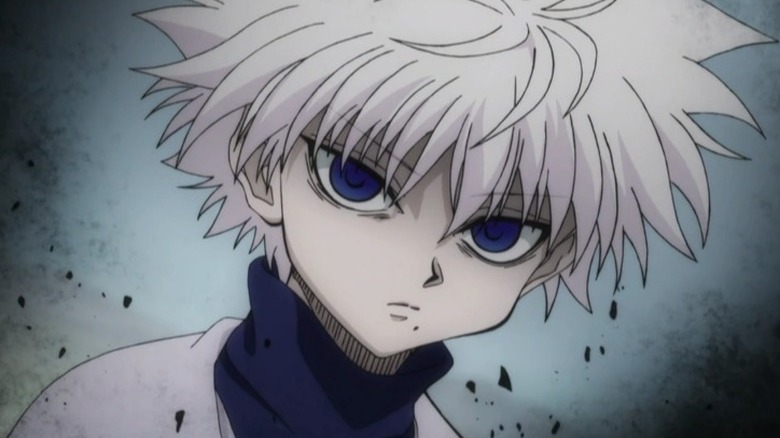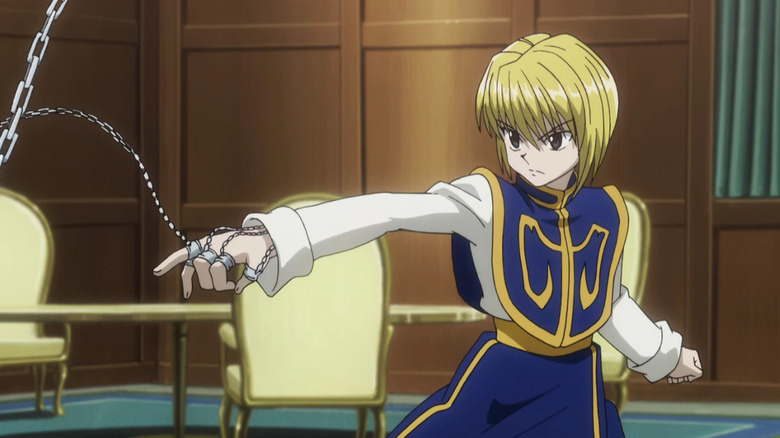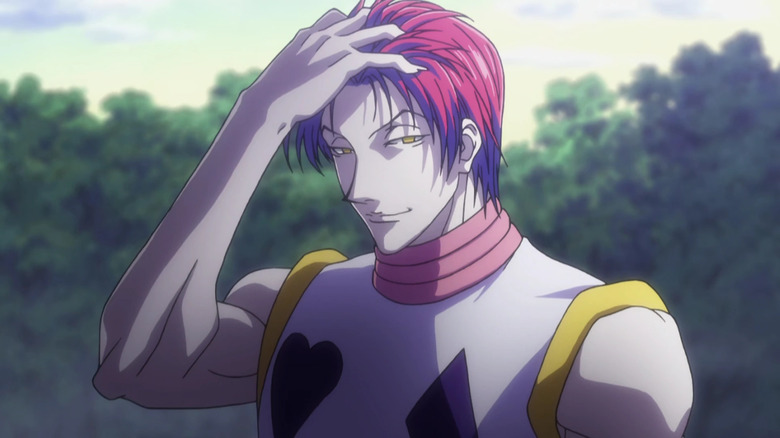The Creator Of Yu Yu Hakusho Recycled His Main Characters For Hunter X Hunter
Mangaka Yoshihiro Togashi has been causing a storm on Twitter/X the past month. Why? Because he's revealed he's working on new chapters of his manga, "Hunter x Hunter." Every day since May 1, 2024, he has tweeted out a screenshot of the pages he completed that day (usually three).
No405、やっております。
ムーン・ヒーリング・エスカレーション! pic.twitter.com/53YDvetlDo
— 冨樫義博 (@Un4v5s8bgsVk9Xp) May 1, 2024
Since 1998, Weekly Shonen Jump magazine has published 400 chapters of "Hunter x Hunter," all written and drawn by Togashi. (The first 339 of those chapters have been animated so far.) If this seems like a slow pace (Eiichiro Oda has crafted 1100+ chapters of "One Piece" in the same timeframe), it's because "Hunter x Hunter" has frequently gone on hiatuses due to Togashi suffering chronic back pain, leaving it difficult for him to draw. Fans can only guess when new chapters will come, which is why Togashi's consistent tweets have mouths watering.
Before "Hunter x Hunter," Togashi's breakout hit was "Yu Yu Hakusho," published from 1990 to 1994. (This title, not translated from Japanese even for English release, loosely means "Ghost Files.") Writing for /Film, Adam Wescott dove deep into Togashi's history and how his experience "Yu Yu Hakusho" has shaped his approach to "Hunter x Hunter."
The two series are so intertwined that their main characters (both organized into groups of four) are near mirror images of each other.
How Yu Yu Hakusho and Hunter x Hunter compare
"Yu Yu Hakusho" is the tale of Yusuke Urameshi, a Japanese teenage delinquent. Aside from his childhood (girl)friend Keiko Yukimura, everyone agrees Yusuke is good for nothing — until he pushes a young boy out of incoming traffic and dies himself. This was so unexpected, not even the rulers of the afterlife saw it coming. So, Spirit King Koenma decides to give Yusuke a second shot at life, but the catch is, the boy must work for Koenma as a "Spirit Detective" who handles evil demons.
Yusuke forms a core team of three allies: his fellow punk and old rival Kazuma Kuwabara, the fox demon/human hybrid Kurama, and the bad-tempered fire demon Hiei. Across the series, their adventures include everything from demon fight clubs to zombie invasions.
"Hunter x Hunter" has a much grander scope; for one, it takes place in a fantasy world, not a version of ours like "Yu Yu Hakusho" does. Gon Freecss is a plucky 12-year-old orphan raised by his aunt on Whale Island. One day, he learns his father Ging is a "Hunter," an elite group of explorers, bounty hunters, scientists, archaeologists, etc. Gon decides to become a Hunter too in hopes he can meet his dad. At the Hunter entrance exam, he makes three friends who each have their own goals: Leorio Paradinight (studying to be a doctor), Kurapika (hunting the gang that murdered his family), and Killua Zoldyck (the child of elite assassins who's looking for his first taste of a normal childhood).
Togashi used "Hunter x Hunter" partially so as to keep drawing strange new creatures (he's a fan of artist H.R. Giger, who designed the Xenomorph in "Alien"). His new main characters, though, are echoes of the ones he created for "Yu Yu Hakusho."
Yusuke Urameshi x Gon Freecss
Togashi's two protagonists are the characters in their overlapping quartets who are the least like each other. Now, Gon and Yusuke have some design similarities, such as green-tinted black hair (though Yusuke's is slicked back while Gon's is spiky in the way only anime hair can be). They also both wear green as their primary color; Yusuke a button-down Japanese school uniform, and Gon a green-orange jacket/shorts/boots combo perfect for hiking.
Their personalities, though, are opposite. Yusuke is surly and cynical, Gon is plucky and naive. They share some baseline immaturity (they are a teen and tween, respectively) and black-and-white views of the world, but their childishness results in different demeanors (rudeness for Yusuke, friendliness for Gon).
Like most of Togashi's heroes, both of these two also have a single signature ability; for Yusuke and Gon, these both manifest as energy fired from their hand. Yusuke has a "spirit gun" — a finger gun that actually shoots something (bursts of Yusuke's channeled spirit energy, specifically). Gon's is "Ja Jan Kan" —"Jankan" is the Japanese word for rock-paper-scissors and Gon's power is modeled after the game. As he channels power into his fist, he can use either rock (a powerful punch), scissors (an energy sword), or paper (an energy blast not unlike Yusuke's spirit gun).
Both Yusuke and Gon's respective powers are modeled on childish games, reflecting how both characters are young men who have the reality of the world slammed in their face.
Kazuma Kuwabara x Leorio Paradinight
In both "Yu Yu Hakusho" and "Hunter x Hunter," Togashi uses the tallest main character (Kuwabara and Leorio, respectively) as the comic relief.
Kuwabara isn't a total idiot (he proves he can be a decent student when he puts the effort in), but he's not much of a thinker and even more short-fused than Yusuke. This winds up making him the butt of a scene's joke many times over, whether because he bit off more than he could chew or didn't think carefully before he spoke.
Leorio shares Kuwabara's cockiness and histrionics, but his comedy isn't quite the same "lovable dumbass" flavor. Note how Leorio is drawn as wearing a suit and glasses, while his height is used to convey how he's the oldest of the main characters; he's coded as more intelligent and mature than Kuwabara ever was. Instead, Leorio's funny moments more come from him trying to act like a leader, and failing, or how he tries to weasel his way out of dangerous situations. He's not a coward but he's the least adventurous of his four friends.
Leorio isn't the only Kuwabara analogue in "Hunter x Hunter." The series' fifth arc introduces the hunter Knuckle Bine, who has a similar pompadour haircut as Kuwabara does. In the "Hunter x Hunter" English dub, Knuckle's actor Ben Diskin even seems to be channeling Chris Sabat's performance as Kuwabara.
Kurama x Kurapika
If you watch enough anime, you'll often have the experience of seeing a character still on a poster, thinking they're a girl, then watching the series and realizing they're actually an androgynous boy. This happened to me both on "Yu Yu Hakusho" with Kurama and then on "Hunter x Hunter" with Kurapika. Both characters have soft features and long hair, and so don't look especially masculine.
Their effeminacy (and the first two syllables of their names) aren't the only qualities they share. Both Kurama and Kurapika are the smart ones of their friend circle (the former especially lives up to his animal side's reputation with a foxy wit). They also both fight with whip-like ranged weapons. Kurama's demon power is tied to plant life, so he uses a "Rose Whip" (a thorny vine). Kurapika uses chains, conjured from his very soul, that extend like tendrils from each of the five fingers on his right hand.
Kurapika is the sole survivor of the Kurta Clan, a small village known for their beautiful scarlet eyes; his kinsmen were killed by the criminal Phantom Troupe to steal their eyes. Now, Kurapika lives only to hunt them: "I do not fear death. I fear only that my rage will fade." Thus, his "Judgment Chain" is a symbolic weapon; Kurapika believes the Troupe is an evil that must be "chained down," but it also represents how his obsessive quest for revenge is itself like a self-imposed chain.
Kurama's backstory is less dark; a fox demon thief possessed a newborn infant to flee justice, but came to truly love his mortal mother. Regardless, he, like Kurapika, is the most polite yet unexpectedly ruthless of his fellow leads. Just as Kurapika's scarlet eyes can boost his power, Kurama can transform to his old white-haired demon appearance to claim victory.
Hiei x Killua Zoldyck
The fourth member of these groups is, in both "Yu Yu Hakusho" and "Hunter x Hunter," the most bloodthirsty.
In the former, it's Hiei. Often compared to Vegeta from "Dragon Ball" (down to the diamond shaped hair), Hiei is introduced as Yusuke's enemy but after being defeated, they team up. (Part of Hiei's parole conditions include helping the Spirit Detective.) Whether fighting for the angels or demons, Hiei remains humorless (aside from poking fun at Kuwabara) and only ever cracks a smile when in battle.
Like Hiei, Killua is short with spiky-hair (his snow white tones contrasting Hiei's pitch black ones), and his electrical powers are similar to Hiei's fire powers. One of Hiei's finishing moves is "Dragon of the Darkness Flame," where he summons a stream of black fire shaped like a dragon's maw. In "Hunter x Hunter," Killua's grandfather — the assassins Silva Zoldyck — has a similar "Dragon Lance" attack. I like to think Togashi is being cheeky in giving Killua's ancestor one of Hiei's moves.
Speaking of family, both characters have plenty of drama there. Hiei's clan, a group of female ice demons, exiled him for being born a male fire demon. His twin sister, Yukina, remains unaware of their connection even after they reunite. Killua, meanwhile, has to deal with his family always hounding him to come home and take over the family assassination business, even though he wants to forge his own destiny.
Aside from their violent dispositions, though, Hiei and Killua aren't that similar. Hiei is rude, while Killua is a chipper kid — who is also a terrifying killer. The dissonance of those two traits forms the core of his character. While Hiei and Yusuke only manage grudging respect, Gon and Killua are each others' best friend; for the series' first six arcs, they're almost never apart.
How the group dynamics of Yu Yu Hakusho and Hunter x Hunter differ
It takes a while in "Yu Yu Hakusho" for the four main leads to unite as one (14 episodes of the anime) but once they do, they stick together for nearly the whole series. Kuwabara taps out for much of the last story arc (choosing to focus on studying instead of demon-slaying), but returns by the end.
The stories of "Yu Yu Hakusho" can be thin; the second major arc, "The Dark Tournament," dispenses with any pretense that there's more to the plotting than demon slug matches. The series' greatest strength is its four man ensemble; a big enough core cast for character conflict, but never too much that it feels crowded. The four's interwoven dynamics hook and keep you engaged through the fights.
The first arc of "Hunter x Hunter," where our leads go through test after test at the Hunter exam, gives the impression that the series will go the same way. Nope; Leorio and Kurapika tap out of the second arc, and then once the group comes back together, the third focuses mostly on Kurapika pursuing his vengeance alone. The fourth and fifth arcs star only Gon, Killua, and a new mountain of supporting characters. The current ongoing arc (not yet animated) is back to starring Kurapika.
The structure of "Hunter x Hunter" prioritizes innovation and story shifts. If you find yourself getting comfortable in one nook of the setting, though (I'm most invested in Kurapika's quest for justice), such changes can't help but frustrate.
The villains of Yu Yu Hakusho and Hunter x Hunter
The other major change between these two series is how in "Hunter x Hunter," Togashi introduced a fifth core character: Hisoka Morow. A sadistic adrenaline junkie who dresses like a playing-card themed clown, Hisoka is (pardon the pun) the wild card of "Hunter x Hunter." He's no good guy, but he's so self-interested that he can sometimes be an ally of convenience to the heroes.
Hisoka is more like the Joker (or, for you "Simpsons" fans, Sideshow Bob) than any character out of "Yu Yu Hakusho." One could strain a comparison between him and the demon Toguro; both are addicted to fighting and seek to groom the lead hero into their greatest opponent. Toguro, though, styled and carried himself like a grim gangster, the total opposite of Hisoka's flamboyance. He was also a pure antagonist despite a tragic backstory, whereas Hisoka can sometimes help the heroes but has no such sob story.
"Hunter x Hunter" is a series where an author is constantly challenging himself to either try new stories or refine his old ones. That mindset is clearest in how he constructs his characters, but Hisoka is just one piece of evidence that Togashi's mind is never wanting for more ideas.
